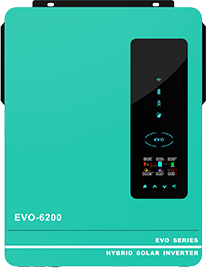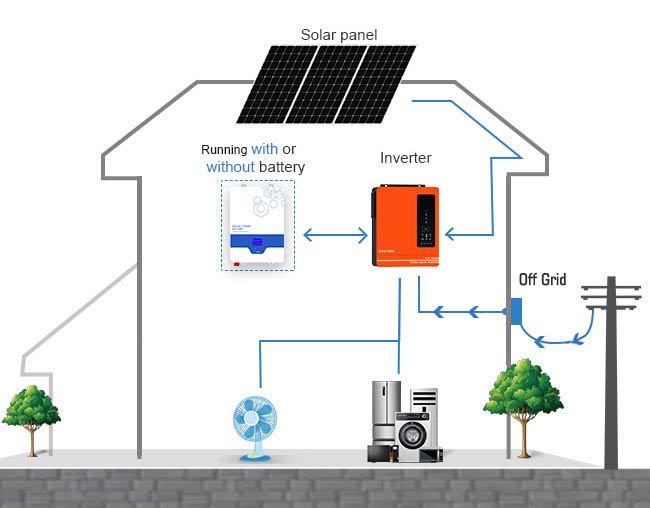

In an era where sustainable energy options are gaining increasing popularity, individuals and enterprises alike are seeking methods to optimize their energy consumption and enhance their commitment to the environment.
As solar panels are being deployed on roofs worldwide, a pivotal advancement toward achieving a streamlined and eco-friendly energy system is represented by the hybrid inverter. This electronic device facilitates the integration of solar panels, batteries, and the conventional power grid, enabling them to operate harmoniously instead of independently.
Hybrid inverters represent an innovative solar technology that merges the advantages of a conventional solar inverter with the adaptability of a battery inverter, all within a singular apparatus. This cutting-edge device offers a compelling solution for homeowners seeking to implement a solar power system that accommodates future enhancements, such as the incorporation of a battery storage system.
In this article, we will introduce what hybrid inverters are and their functions, how they work, teh differences between the normal inverter, off grid inverter and hybrid solar inverter, and also key factors when choosing a hybrid solar inverter, etc. Let’s get started!
A hybrid solar inverter is a device that combines the functionalities of a solar inverter and a battery inverter into a single unit. Its main function is to manage the flow of electricity between solar panels, batteries, and the electrical grid in a hybrid solar power system.

The hybrid solar inverter converts the direct current (DC) electricity generated by the solar panels into alternating current (AC) electricity, which can be used to power household appliances and fed into the electrical grid.
If the solar panels produce more electricity than is immediately needed, the excess energy can be stored in batteries for later use. The hybrid inverter manages the charging process of the batteries, ensuring they are efficiently and safely charged from the solar panels.
When there is a demand for electricity but the solar panels are not generating enough or no power, the hybrid inverter can draw electricity from the batteries to supply the required energy. This feature enables the system to provide electricity during periods of low sunlight or during a power outage.
In a hybrid solar power system, the hybrid inverter can also interact with the electrical grid. It allows for two-way power flow, meaning that excess electricity from the solar panels or batteries can be fed back into the grid, while electricity can also be drawn from the grid when needed. This interaction with the grid provides additional flexibility and reliability to the system.
Hybrid solar inverters typically include monitoring and control capabilities. They can track the performance of the solar panels, batteries, and overall system, providing real-time data on energy production, consumption, and storage. Some inverters also offer advanced features like remote monitoring and control via smartphone apps or web interfaces.
By combining the functions of a solar inverter and a battery inverter, a hybrid solar inverter simplifies the installation and management of a hybrid solar power system. It optimizes energy usage, increases self-consumption of solar power, and provides backup power during outages, making it a versatile and efficient component of a renewable energy setup.
A hybrid inverter, also known as a multi-mode inverter, is a device that combines the functionalities of a grid-tied inverter and a battery-based inverter. Its primary purpose is to manage the flow of electrical energy between renewable energy sources, such as solar panels or wind turbines, the electric grid, and energy storage systems like batteries.
The working principle of a hybrid inverter involves different modes of operation depending on the available energy sources and the demands of the electrical system. Here is a general overview of its operation:

In this mode, when the solar panels or other renewable energy sources generate electricity, the hybrid inverter converts the DC (direct current) power produced by these sources into AC (alternating current) power that can be used by household appliances or fed back into the electrical grid. It synchronizes the AC voltage and frequency with the grid to ensure a stable and safe connection.
When excess energy is generated by the renewable energy sources but not immediately consumed or exported to the grid, the hybrid inverter diverts the surplus energy to charge the connected battery storage system. It regulates the charging process to optimize battery performance and prevent overcharging.
During times when the renewable energy sources cannot meet the electricity demand, such as at night or during periods of low solar irradiation, the hybrid inverter utilizes the energy stored in the batteries. It converts the DC power from the batteries into AC power to power the connected loads, providing continuous electricity supply even when the grid is unavailable.
In the event of a power outage or a failure in the grid supply, the hybrid inverter can automatically switch to a grid backup mode. It disconnects from the grid and operates in an islanded mode, using the energy stored in the batteries to power essential loads, ensuring uninterrupted electricity supply.
To enable these different modes of operation, a hybrid inverter incorporates advanced control algorithms and power electronics components. These components include DC-AC converters, MPPT (Maximum Power Point Tracking) controllers for solar panels, battery charge controllers, grid synchronization circuits, and protective devices to ensure safe and efficient operation.
It's important to note that the specific working principle of a hybrid inverter may vary depending on the manufacturer and the design of the system. Therefore, it's always recommended to refer to the manufacturer's documentation or user manual for detailed information on a particular hybrid inverter model.
| Normal Inverter | Hybrid Inverter | |
| Functionality | A normal inverter converts direct current (DC) power from a battery or solar panels into alternating current (AC) power to run household appliances during power outages. | A hybrid inverter performs the same function as a normal inverter, but it also has additional capabilities to manage multiple energy sources, such as solar panels, batteries, and the grid. It can optimize energy usage by intelligently switching between different power sources based on availability and demand. |
| Energy Sources | A normal inverter typically works with a single energy source, such as a battery or solar panels. | A hybrid inverter can handle multiple energy sources simultaneously. It can integrate power from solar panels, batteries, and the grid, allowing for greater flexibility and energy management. |
| Battery Charging | A normal inverter can charge batteries using power from the grid or a generator, but it cannot charge batteries using solar power. | A hybrid inverter can charge batteries using solar power, grid power, or a combination of both. It can prioritize solar power to charge batteries during the day and switch to grid power when solar energy is insufficient. |
| Grid Interaction | A normal inverter is not designed to interact with the grid beyond providing backup power during outages. | A hybrid inverter is capable of grid interaction. It can export excess energy generated by solar panels back to the grid, allowing for net metering and potentially earning credits or reducing electricity bills. |
| Energy Management | A normal inverter does not have advanced energy management features. It simply converts DC power to AC power and supplies it to the connected load. | A hybrid inverter typically includes advanced energy management features. It can monitor and optimize energy usage based on factors such as energy prices, time of use, and battery capacity, enabling more efficient energy consumption. |
| Energy Independence | A normal inverter provides backup power during outages but relies on the grid as its primary power source. | A hybrid inverter offers a higher level of energy independence. It can combine energy from solar panels and batteries, reducing reliance on the grid and potentially allowing for off-grid operation in certain scenarios. |
These are the main differences between a Hybrid Inverter and a Normal Inverter. The choice between the two depends on specific energy needs, preferences, and the level of energy management and independence desired.
| Hybrid Inverter | Off-Grid Inverter | |
| Functionality | A hybrid inverter is designed to work in both grid-connected and standalone modes. It can operate with renewable energy sources, such as solar panels and batteries, as well as interact with the utility grid. It offers features like energy storage, backup power, and the ability to export excess energy to the grid. | An off-grid inverter is specifically designed for standalone systems where there is no connection to the utility grid. It is used in off-grid or remote locations and works with batteries and other energy sources to provide power independently. |
| Grid Interaction | Hybrid inverters have the capability to synchronize with the utility grid. They can export excess energy generated from renewable sources to the grid and also draw energy from the grid when needed. | Off-grid inverters are not designed to interact with the utility grid as they are meant for self-contained systems. They do not have the ability to export energy to the grid or receive energy from it. |
| Battery Charging | Hybrid inverters are equipped with battery charging capabilities. They can efficiently charge batteries from different sources, such as solar panels or the grid. They optimize the charging process based on factors like battery capacity and available energy sources. | Off-grid inverters are primarily designed for battery charging in standalone systems. They prioritize charging from renewable energy sources, such as solar panels or wind turbines, as there is no grid backup available. |
| Energy Management | Hybrid inverters have advanced energy management systems that can prioritize and manage different energy sources, including solar power, battery storage, and the grid. They can intelligently switch between these sources based on factors like energy availability, time of day, and demand. | Off-grid inverters may not have the same level of energy management capabilities as hybrid inverters. They are typically designed to rely on renewable energy sources and batteries for power in off-grid systems, without the need for complex energy management functions. |
In summary, the main differences between a hybrid inverter and an off-grid inverter lie in their functionality, grid interaction capabilities, battery charging features, and energy management systems. Hybrid inverters are designed for systems that can operate both on and off the grid, while off-grid inverters are specifically tailored for standalone systems without any connection to the utility grid.
When choosing a hybrid solar inverter, there are several key considerations to keep in mind. A hybrid solar inverter combines the functions of a standard solar inverter with those of a battery storage system. Here are some important factors to consider:

The lifespan of a hybrid solar inverter can vary depending on several factors such as the quality of the product, the operating conditions, and the level of maintenance. On average, a well-maintained hybrid solar inverter can last between 10 to 15 years. However, it's important to note that this is just an estimate, and individual cases may vary.
Yes, a hybrid solar inverter can work without a battery. In fact, hybrid solar inverters are designed to be versatile and can operate in different modes depending on the availability of a battery storage system.
When a hybrid solar inverter is connected to a battery, it can perform multiple functions. It can convert the DC (direct current) electricity generated by solar panels into AC (alternating current) electricity to power your home or business. Additionally, it can charge the battery using excess solar power and draw power from the battery when solar production is low or during nighttime.
However, if a battery is not present or not connected to the hybrid solar inverter, it can still function as a regular solar inverter. It will convert the DC electricity generated by the solar panels into AC electricity, which can be used to power your appliances or exported to the grid if permitted by your local regulations. The absence of a battery means that excess solar power will not be stored and used later, and you will rely solely on solar production during daylight hours.
Hybrid solar inverters are designed to handle grid failures or power outages in different ways, depending on their specific features and configurations. Here are a few common scenarios:
Grid-tie mode: In this mode, when the grid is available, the hybrid solar inverter operates by synchronizing the solar power generation with the grid. If a grid failure occurs, the inverter is programmed to disconnect from the grid and stop exporting power to protect utility workers who may be working on fixing the grid. In this case, the solar panels will not be able to generate electricity, and the inverter will not supply power to your home or business until the grid is restored.
Backup mode: If your hybrid solar inverter is connected to a battery storage system, it can provide backup power during grid failures. When the grid goes down, the inverter can automatically switch to backup mode and draw power from the battery to supply electricity to your home or business. This allows you to continue using essential appliances or maintain critical operations even when the grid is not available. The inverter will switch back to grid-tie mode once the grid power is restored, and it will start recharging the battery using solar energy.
Off-grid mode: Some hybrid solar inverters also have an off-grid mode that allows you to operate independently from the grid. In this mode, the solar panels generate electricity, which is used to power your home or business directly or stored in a battery system. This mode is typically useful in remote areas where grid connection is not available or during extended grid outages. However, it's important to note that off-grid systems require sufficient solar capacity and battery storage to meet your power needs during periods of low solar production.
Click here to get detailed info: How Hybrid Solar Inverters Safeguard Against Grid Failures
During excess solar production with a hybrid inverter, several possible scenarios can occur depending on the setup and configuration of the system.
Grid Feed-in: If the hybrid inverter is connected to the electrical grid, it can feed the excess solar energy back into the grid. This process is known as grid feed-in or grid-tie. The excess electricity is sent to the grid, and the utility company may provide credits or payments for the energy generated.
Battery Charging: If the hybrid inverter is equipped with a battery storage system, it can divert the excess solar energy to charge the batteries. This allows the energy to be stored for later use when solar production is low, such as during the night or on cloudy days.
Load Consumption: In some cases, if there is excess solar energy and the batteries are fully charged, the hybrid inverter can prioritize powering the electrical loads directly. This means that the excess energy is used to run household appliances and devices, reducing the reliance on grid electricity.
Curtailment: If none of the above options are available or feasible, and there is no immediate use for the excess solar energy, the hybrid inverter may have a feature called curtailment. Curtailment involves reducing the solar energy production to avoid overloading the system or wasting the excess energy. This is typically a last resort option and aims to ensure the stability and safety of the electrical system.
Click here to get detailed info: Managing Excess Solar Production with Hybrid Inverters: A Closer Look
Yes, hybrid solar inverters can be suitable for commercial use. Hybrid solar inverters are designed to work with both solar panels and battery storage systems, allowing for greater flexibility and control over the electricity generated from solar energy. They are commonly used in both residential and commercial settings.
Click here to get detailed info: Unveiling the Potential: Utilizing Hybrid Solar Inverters for Commercial Applications
The payback period for a hybrid solar inverter system refers to the amount of time it takes for the initial investment in the system to be recouped through energy savings and potentially other financial benefits. In simpler terms, it is the duration it takes for the cumulative energy savings generated by the system to equal the initial cost of the system. The concept of the payback period is crucial for evaluating the financial feasibility and attractiveness of investing in a hybrid solar inverter system.
Click here to get detailed info: Calculating the Payback Period for Hybrid Solar Inverter Systems: A Comprehensive Analysis
Yes, hybrid solar inverters are designed to be compatible with a variety of battery technologies. Their versatility allows them to work seamlessly with different types of batteries, each with its own characteristics and advantages. This compatibility is a significant advantage, as it enables users to choose the battery technology that best suits their needs, budget, and specific energy goals.
Click here to get detailed info: Hybrid Solar Inverters: Embracing Diversity in Battery Technologies
[1] Solar Hybrid Systems: Design and Application.[J]. Ahmet Aktas, Yagmur Kircicek · 2021
[2] A novel single-stage solar inverter using hybrid active filter with power quality improvement.[J]. B. Mariappan; B. G. Fernandes; M. Ramamoorty, 2014
[3] Analysis of Hybrid Inverter with Solar Battery Charging System.[J]. V. Kalandhar; A. Veera Reddy; G.Y. Tejasree; G. Udith; R. Gowtham Charan; Narendrababu A, 2023
[4] Grid-tied and stand-alone hybrid solar power system for desalination plant.[J]. C Ghenai, A Merabet, T Salameh, EC Pigem - Desalination, 2018 - Elsevier